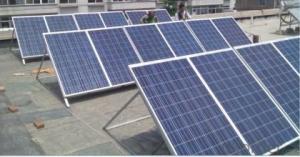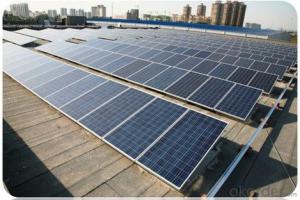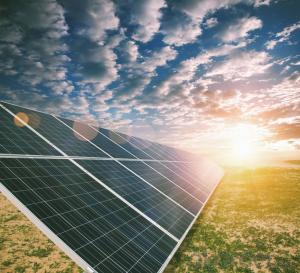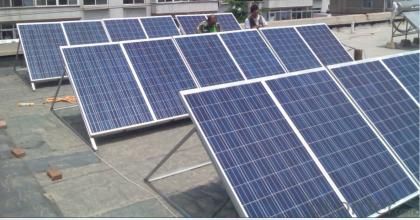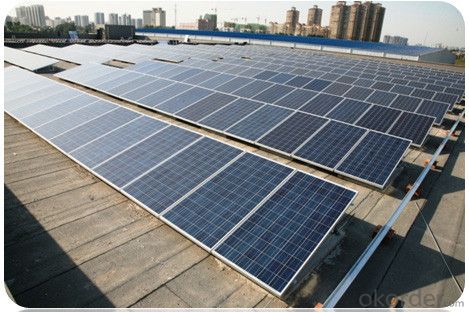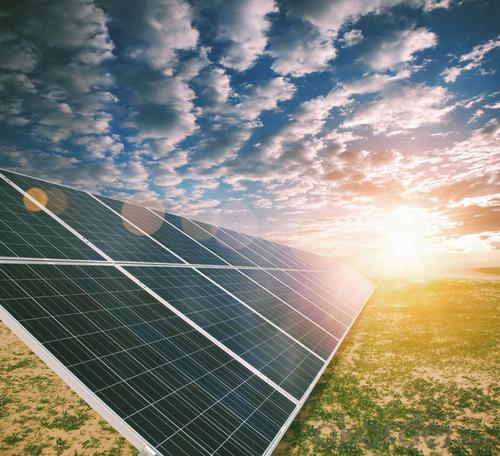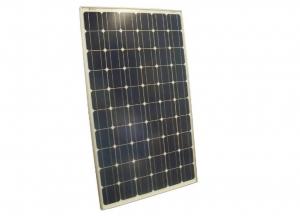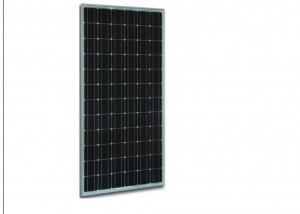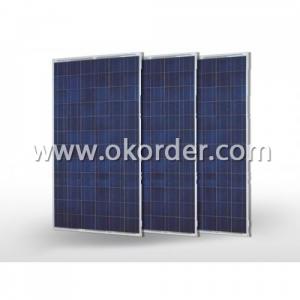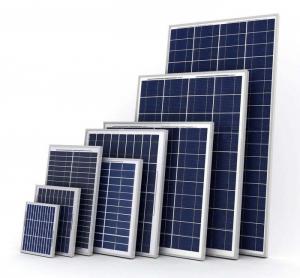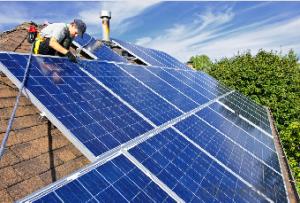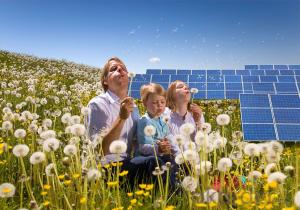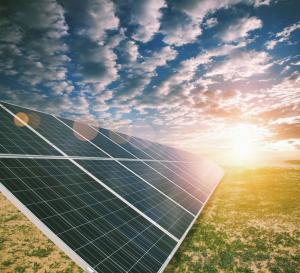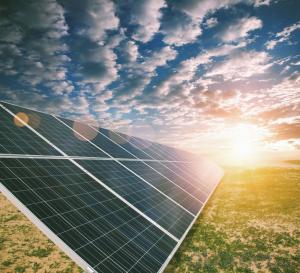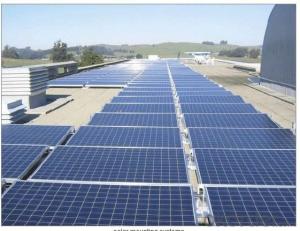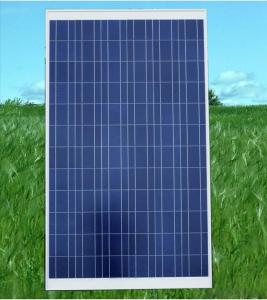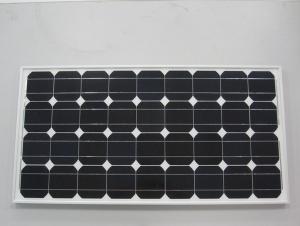Heated Solar Panels for Snow (55-60w) CNBM Solar Polycrystalline 6 Series
- Loading Port:
- China main port
- Payment Terms:
- TT OR LC
- Min Order Qty:
- 100000 watt
- Supply Capability:
- 10000000 watt/month
OKorder Service Pledge
OKorder Financial Service
You Might Also Like
About us
CNBM International Corp, established in 2004, is the business entity for trade and logistic of CNBM Group.With the advantages in Cement, Composite Materials, New Building Materials and Engineering, CNBM mainly concentrate on coal, steel and construction equipments and give priority to solar and wind energy development.CNBM International is highly recognized by its business partners and clients all over the world and has established good business relationship with the customers in over 120 countries and regions all over the world.
Work Principle
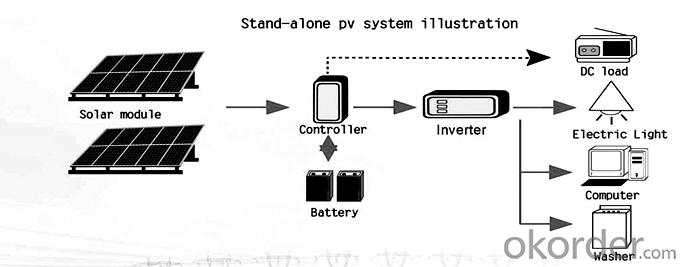
Data sheet
| Characteristics | |
| Max Power Voltage Vmp (V) | 17.4V-17.6V |
| Max Power Current Imp (A) | 3.17A-3.41A |
| Open Circuit Voltage Voc (V) | 22.4V-22.6V |
| Short Circuit Current Isc (A) | 3.38A-3.64A |
| Max Power Pm (W) | 55W-60W |
| Temperature Coefficient of Cells | |
| NOCT | 47℃±2℃ |
| Temperature Coefficients of Isc (%/℃) | 0.06% |
| Temperature Coefficients of Voc (%/℃) | -0.33% |
| Temperature Coefficients of Pmp (%/℃) | -0.45% |
| Mechanical Data | |
| Type of Cells (mm) | Poly156×62.4 |
| Dimension | 820×510×30mm |
| Weight | 4.9kg |
| NO.of Cells and Connections | 3×12=36 |
| Limits | |
| Operating Temperature | –45°C to +80°C |
| Storage Temperature | –45°C to +80°C |
| Max System Voltage | 700V |
Process is as follows:
1, the battery test
2, positive Welding - Inspection –
3, on the back of cascading - Inspection –
4, laying (glass cleaning, material cutting, glass pre-processing, laying) –
5, laminating –
6, to flash ( to the side, cleaning) –
7, fitted border (glue, loading angle keys, punching, install box, scrub I glue) –
8, the welding junction box –
9, high-pressure test –
10, component testing -- -
11 appearance inspection, packaging and storage;
- Q: how much energy or electricity a solar panel produces?
- First, okorder /... Second, as a general rule of thumb, you can generate at most 00 watts of power (.Kwh) per 2 square feet of roof space. I have had to revise my own estimates after building a solar array in my yard using high grade solar panels. Solar panels do not put out their peak rating all the time. NOTE: I am not paid nor given any compensation by solar interests.
- Q: Are there any restrictions or regulations regarding solar panel installations?
- Yes, there are restrictions and regulations regarding solar panel installations. These can vary depending on the country, state, or local municipality. Some common restrictions include zoning laws, building codes, and utility regulations. These regulations may dictate the size, placement, and connections of solar panels, as well as any necessary permits or approvals required for installation. It is important to consult with local authorities or a professional installer to ensure compliance with all applicable restrictions and regulations.
- Q: Can solar panels be used in areas with high levels of air turbulence or strong winds?
- Yes, solar panels can be used in areas with high levels of air turbulence or strong winds. However, it is essential to ensure that the solar panel installation is designed and mounted properly to withstand these conditions. The panels should be securely fastened and angled correctly to minimize the impact of strong winds. Additionally, using durable and wind-resistant materials for the solar panel structure is important to ensure their longevity in such areas.
- Q: I really would like to have my own solar panel, but i don't know how. Most of the panels i have looked at are for car batteries but i'm not sure how this would be able to be transfered into electricity. I'm looking to power things like lamps, a stereo and various chargers for phones and ipods. Please explain to me how i could adapt a solar panel to my uses. Thank you.
- Sounds okorder .. I've seen the particular device listed there. While the lamp is mediocre for an LED light source, the panel is excellent - real polysilicon wafers, in an aluminum frame. Same construction as the kind of panels in commercial installations.
- Q: Can solar panels be used in areas prone to hurricanes or earthquakes?
- Yes, solar panels can be used in areas prone to hurricanes or earthquakes. However, they need to be properly installed and reinforced to withstand the potential impact. Additionally, in areas prone to hurricanes, it is recommended to have a plan in place to secure or remove the panels before the storm hits to prevent potential damage.
- Q: Solar panel packages have different levels of power. For instance you can get a kw system but is this kw per hour or day. How does this work?
- That means if you stick a watt meter on the output when there is maximum design sunlight on it you will get kw. If you shine the maximum design sunlight on it for hour then you get kw hour of power. In one day you get 24kw hours assuming you can get 24 hours of maximum design sunlight. Your home electric bill is typically in kw hours. At the macro level power is traded at megawatt hours.
- Q: How do solar panels affect the property's energy independence?
- Solar panels can greatly enhance a property's energy independence by harnessing the sun's energy to generate electricity. By producing renewable energy on-site, solar panels reduce dependence on the traditional power grid and decrease reliance on fossil fuels. This allows property owners to generate their own clean, sustainable energy, leading to reduced electricity bills and a more environmentally friendly lifestyle.
- Q: So you know how the bigger the surface area exposed to the heat radiation means the quicker it'll heat up.Is this what happens with solar panels, they have a large surface area exposing to the sun, so they can get more heat?
- - Radiation from the sun is mostly Ultra- Violet. - There are 2 types of solar panels, Solar thermal collectors and photovoltaic cells. - Put simply, photovoltaic cells take the UV rays and produce electricity. - Solar thermal collectors (which is probabl
- Q: I am in need of solar panels and the batteries that I can store the energy in. I need to be able to run a laptop, cell phone, and LED lights from it. When I research I see all sorts of options with regards to watts, VMPs, and AMPs. I also see that I may need a controller, an inverter, and various other components. Can anyone help me through these terms and what i need to know in order to efficiently generate and store the electricity. Thanks
- Unlike what most people seem to think, solar panels are not advanced enough to power day to day objects that we use, with the sun that we see in a day. You would need mass amounts of panels and equipment. IF there is a smaller solutions (which I doubt would do what you're asking yet) it would cost thousands of dollars. Panels are not there yet, and the ones that are, are still in development or being guarded from release to the public. The most you'll get out of a few hundred bucks and panels is a lit garden for a few hours at night. Go buy rechargeable batteries.
- Q: What makes them stop working after a while?
- They are used in an environment that's very harsh for semiconductors, especially the high temperatures. Ion migration and many other failure mechanisms increase with temperature. Thermal expansion adds its own mechanical stresses.
Send your message to us
Heated Solar Panels for Snow (55-60w) CNBM Solar Polycrystalline 6 Series
- Loading Port:
- China main port
- Payment Terms:
- TT OR LC
- Min Order Qty:
- 100000 watt
- Supply Capability:
- 10000000 watt/month
OKorder Service Pledge
OKorder Financial Service
Similar products
Hot products
Hot Searches
Related keywords
